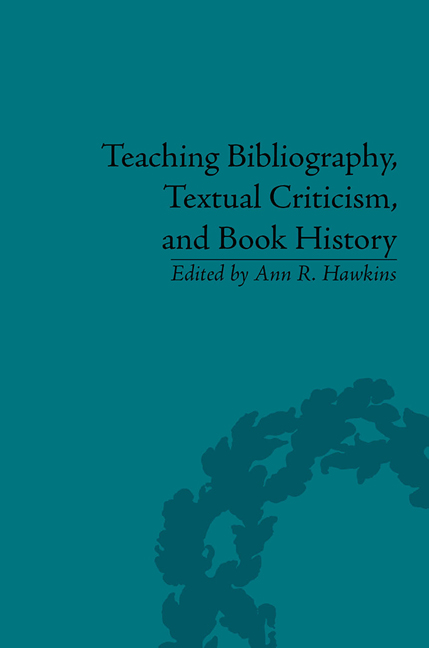Book contents
- Frontmatter
- Contents
- Notes on Contributors
- Foreword
- Introduction: Towards a pedagogy of Bibliography
- Part I Rationales
- Part II Creating and Using Resources
- Part III Methodologies
- Teaching ‘History of the Book’
- Teaching Bibliography and Research Methods
- The Bibliography and Research Course
- Integrating ‘Bibliography’ with ‘Literary Research’: A Comprehensive Approach
- The Hidden Lives of Books
- Learning from Binders: Investigating the Bookbinding Trade in Colonial Philadelphia
- Papermaking, History and Practice
- The Bibliographical Analysis of Antique Laid Paper: A Method
- Teaching Textual Criticism
- Part V Resources
- Index
The Hidden Lives of Books
from Teaching Bibliography and Research Methods
- Frontmatter
- Contents
- Notes on Contributors
- Foreword
- Introduction: Towards a pedagogy of Bibliography
- Part I Rationales
- Part II Creating and Using Resources
- Part III Methodologies
- Teaching ‘History of the Book’
- Teaching Bibliography and Research Methods
- The Bibliography and Research Course
- Integrating ‘Bibliography’ with ‘Literary Research’: A Comprehensive Approach
- The Hidden Lives of Books
- Learning from Binders: Investigating the Bookbinding Trade in Colonial Philadelphia
- Papermaking, History and Practice
- The Bibliographical Analysis of Antique Laid Paper: A Method
- Teaching Textual Criticism
- Part V Resources
- Index
Summary
Readers search for the writings they may want to see, librarians for titles they may want to acquire and catalogue, dealers for the books they handle. Usually this is routine work. For difficult cases, special strategies are often needed, and rewards often ensue. Those who look for obscure titles in out-of-the way sources pick up a range of odd stories about books and their historical contexts, along with impressions of the nature of our bibliographical record. The strategies of searching (finding citations for what you want) and verification (making sure what you find is what you really need) are usually learned by experience But can they be taught?
I have attempted to teach them in two settings: in library school (University of Illinois, Urbana) over a semester, to students mostly with humanities backgrounds; and at Rare Book School (Columbia University, now University of Virginia), over a very busy full-time week, mostly to librarians. My model was a course with R. C. Stewart (then head of acquisitions at the University of Michigan library); my interest was sustained by discoveries in Richard Altick's The Art of Literary Research, in the Library of Congress's long-abandoned ‘Weekly List of Unlocated Research Books’, and in my library work.
Teaching Strategies
A whole course devoted to searching and verification would be impossible without a strong library collection like that at Illinois. While the wonderful reading room in the Butler Library at Columbia was a particular joy to watch the class use, the smaller setting in Charlottesville proved almost as effective. Joel Silver's enviable setting in the Lilly Library at Indiana encourages a close study of the major bibliographies themselves. Book history courses are bound to benefit from searching experience, whether informally, as will happen naturally, or formally, as I attempted.
- Type
- Chapter
- Information
- Teaching Bibliography, Textual Criticism, and Book History , pp. 124 - 131Publisher: Pickering & ChattoFirst published in: 2014



